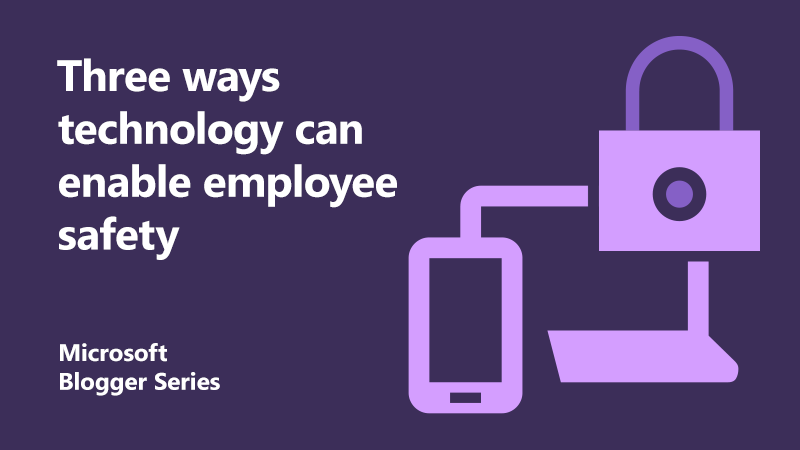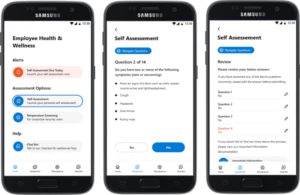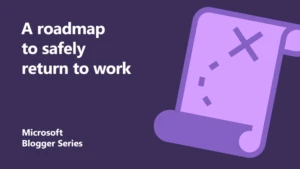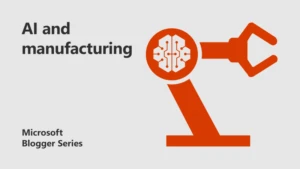
Return to work: Three ways technology can enable employee safety
As manufacturers return to work, it’s not to the same offices and factories as before. Workplaces will require thoughtful changes in the way they set up and operate to help keep employees safe. At the same time, employees will have new expectations on the way they work and how they choose to do so. Those who can work from home will likely want to maintain that flexibility when offices open back up, as they’ve seen the benefits of doing so for the last few months already. Technology like Teams will make it easy for co-workers to collaborate and work from anywhere, whether they decide to return to the workplace or continue working remotely.
By taking a people-first approach to returning to the workplace, organisations will drive better engagement from their employees in demonstrating that they are putting employee safety and wellbeing above all else.
Using tech to empower employee safety
Our workspaces need to be optimised for social distance, as well as resilience. Using technology to optimise the workforce is the best way to make it easy for them to do their best work and to create workplaces where employees feel safe and protected.
Our partners have been instrumental in helping organisations ensure an efficient return to work, while prioritising employee safety. Transparity is a great example of this as they’ve been at the forefront of helping customers respond to COVID-19, from helping transition to remote working at the start, to enabling a safe return to work as we begin to adjust to the new normal. At a recent hackathon, they created a no/low code app via Power Apps that helps improve employee health and wellbeing. Because the app is quick to build, you can implement it quickly across your factories and offices and it can also be customised to suit specific business needs and requirements.
Here are three ways you can use Transparity’s PowerApp to keep your employees safe and healthy when planning the return to work:
 1. Track symptoms with thermal imagery
1. Track symptoms with thermal imagery
Part of the ‘new normal’ is looking at your workplaces and how they can be adapted to social distancing, such as implementing clear guidance on social distancing in workplaces. Provide PPE, such as gloves, face shields, masks as well as hand sanitiser and handwashing stations. This will help show employees that their health is the priority when they return.
Take a look at some easy technological solutions too. For COVID-19, body temperature is a key indicator of infection. By placing thermal cameras at entrances, you can use Transparity’s app to track employee’s temperatures easily. If an employee has a higher than average temperature, they are sent additional information via the app. The employee’s line manager is also notified; and where needed, additional measures can be put in place.
 2. Identify risks through proactive monitoring
2. Identify risks through proactive monitoring
Part of empowering employees is to ensure their voices are heard. This can be as simple as asking employees to complete a self-assessment on a weekly basis. This proactive monitoring is one that enables an organisation to identify employees who may present with symptoms in the future.
3. Maintain clear communication
The best way to keep employees engaged is to keep lines of communication open, listening, and implementing feedback, especially through times of change.
Regular virtual meetings, Q&As and even quick email messages are great ways to give updates, information, and connect with the workforce. For quick information, an app with Microsoft Power Virtual Agent built in lets users ask commonly asked questions and receive this information in real-time. It can link out to relevant company information and escalate to a team if an answer can’t be found.
Creating an employee-centric culture
By implementing technology that supports a safe return to work, manufacturers will show their employees that they’re leading people-first rather than profit-first. This will create a workforce of supportive, engaged employees who are confident to return to work in their best way.
Find out more
A Year of Change: Digital Transformation Trends in 2020 e-book
Building your first business app
The total economic impact of Power Apps
A roadmap to recovery: How manufacturers can return to work safely
About the author
 Richard is responsible for leading Microsoft’s approach into the UK Manufacturing industry.
Richard is responsible for leading Microsoft’s approach into the UK Manufacturing industry.
Richard joined Microsoft 14 years ago, where he has held various leadership roles across the business, the most recent of which is to establish and drive Microsoft’s strategy into the UK Industrial sector. He works closely with businesses and partners across automotive, aerospace, and manufacturing focussing on how digital transformation can enable them to achieve more.
He also works closely with associated industry bodies and consortia, supporting industry collaboration, growth and skills development.
Richard holds a Bachelor of Arts Degree in Accounting.




